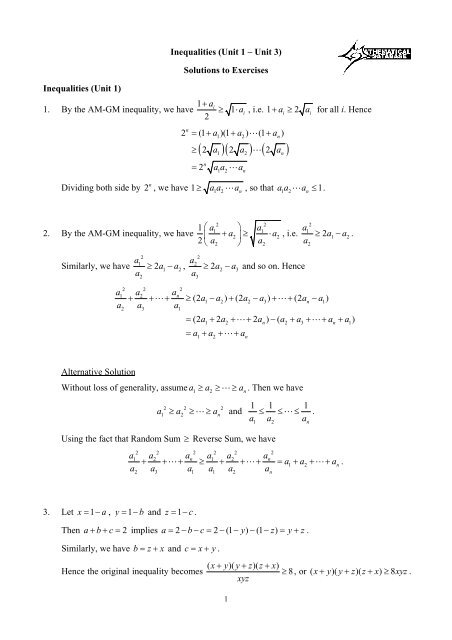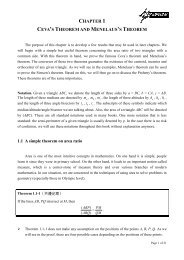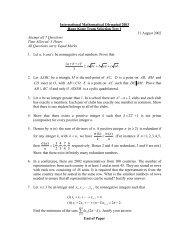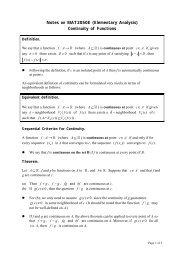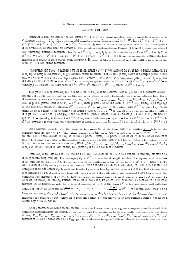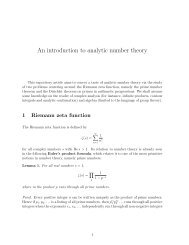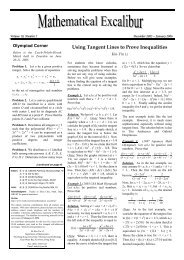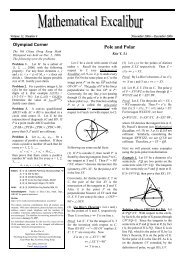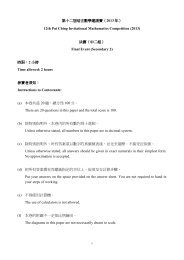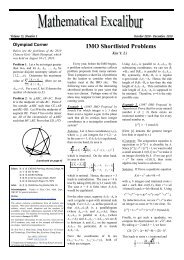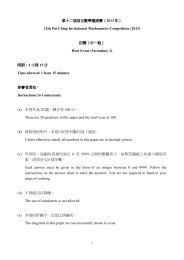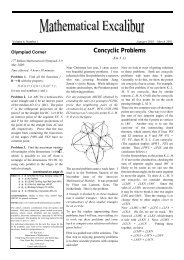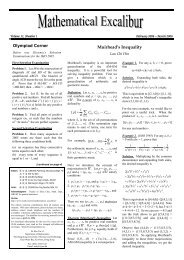Inequalities (Unit 1 â Unit 3) Solutions to Exercises Inequalities (Unit ...
Inequalities (Unit 1 â Unit 3) Solutions to Exercises Inequalities (Unit ...
Inequalities (Unit 1 â Unit 3) Solutions to Exercises Inequalities (Unit ...
- No tags were found...
You also want an ePaper? Increase the reach of your titles
YUMPU automatically turns print PDFs into web optimized ePapers that Google loves.
By the AM-GM inequality, we haveSimilarly, y+ z ≥ 2 yz and z+ x≥ 2 zx.x+ y ≥ xy , i.e. x + y≥ 2 xy .2Consequently, ( )( )( )( x + y)( y+ z)( z+ x) ≥ 2 xy 2 yz 2 zx = 8xyz, completing the proof.4. Without loss of generality, assume a≥b≥ c.Then1 1 1≥ ≥b+ c a+ c a+ b.Using the fact that Direct Sum ≥ Random Sum, we havea b c b c a+ + ≥ + +b+ c a+ c a+ b b+ c a+ c a+bTaking another random sum, we havea b c c a b+ + ≥ + + .b+ c a+ c a+ b b+ c a+ c a+bAdding the above two inequalities, we have⎛ a b c ⎞ b+ c a+ c a+b2⎜+ + ⎟≥ + + = 3,⎝b+ c a+ c a+ b⎠b+ c a+ c a+bso thata b c+ + ≥b+ c a+ c a+b32.Alternative SolutionBy the Cauchy-Schwarz inequality, we have⎛ a b c ⎞⎜ + + ⎟ + + + + + ≥ + +⎝b+ c a+ c a+b⎠Hence it suffices <strong>to</strong> prove thatBy the AM-GM inequality,2[ a( b c) b( c a) c( a b) ] ( a b c)2( a+ b+c) 3 .≥ab ( + c) + bc ( + a) + ca ( + b) 22 2 2 2 2 22( + + ) = 2 + 2 + 2 + 4 + 4 + 4a b c a b c ab bc caso that the desired inequality follows.2 2 2 2 2 2= ( a + b ) + ( b + c ) + ( c + a ) + 4ab+ 4bc+4ca≥ 2ab + 2bc + 2ca + 4ab + 4bc + 4ca[ ab c bc a ca b]= 3 ( + ) + ( + ) + ( + ).2
5. Let b1 < b2 < < bnbe a permutation of a1, a2, …, anin ascending order.Since a1, a2, …, anare distinct positive integers, we have bi≥ i for all i.Using the fact that 1≥ 1 ≥ ≥1 and that Random Sum ≥ Reverse Sum, we have22 n2a a b ba + + + ≥ b + + +2 n 2 n2 n≥ 1+ + +22 2n1 1= 1+ + +2 n2 n2n1 2 2 1 2 23
xy + yz + zx − 3 xyz = xy(1 − z) + yz(1 − x) + xz(1 − y)= xy( x+ y) + yzy ( + z) + xzz ( + x)2 2 2= x ( y+ z) + y ( x+ z) + z ( y+x)2 x x2Since x (1 −x) − =− (1−2 x) ≤ 0 , we have4 4ySimilarly, y2 (1 − y)≤ and4= (1 − ) + (1 − ) + (1 − )2 2 2x x y y z zxx2 (1 − x)≤ .4zz2 (1 −z)≤ . Consequently,42 2 2 x y z 1xy + yz + zx − 3 xyz = x (1 − x) + y (1 − y) + z (1 −z)≤ + + = .4 4 4 43. After some trial, we find that equality holds when the two triangles on the left hand side aresimilar, i.e. whenx y z= = .x ' y' z'This is clearly the equality condition for the Cauchy-Schwarz inequality. Therefore, weattempt <strong>to</strong> use the Cauchy-Schwarz inequality <strong>to</strong> solve the problem.Now we must express the area of a triangle in terms of its side lengths. Clearly, we should usethe Heron’s formula, which states that the area of a triangle with side lengths a, b, c isss ( − a)( s−b)( s− c),wherea+ b+cs = . Hence the original inequality becomes2ss ( −x)( s− y)( s− z) + s'( s' −x')( s' − y')( s' −z')4 4≤4+ + − − + − − + − −( s s')( s s' x x')( s s' y y')( s s' z z')x + y+zwith s = and2havex ' + y' + z's ' = . Now, using the Cauchy-Schwarz inequality twice, we2ss ( −x)( s− y)( s− z) + s'( s' −x')( s' − y')( s' −z')4 4≤ ⎡ s( s x) s'( s' x') ⎤ ⎡ ( s y)( s z) ( s' y')( s' z')⎤⎣− + −⎦⋅⎣− − + − −⎦≤ ( s+ s')( s− x+ s' −x') ⋅ ( s− y+ s' − y')( s− z+ s' −z')=4+ + − − + − − + − −( s s')( s s' x x')( s s' y y')( s s' z z')and so the original inequality is proved.5
4. Let a2004 = 1 − a1− a2− − a2003. Then a1 + a2 + + a2004 = 1 andaa 1 2a2003(1 −a1 −a2 − −a2003)aa1 2a2004= .( a + a + + a )(1 −a )(1 −a ) (1 −a ) (1 −a )(1 −a ) (1 −a)1 2 2003 1 2 2003 1 2 2004By the AM-GM inequality,(1 −a1 )(1 −a2) (1 −a2004)= ( a + a + + a )( a + a + + a ) ( a + a + +a )2 3 2004 1 3 2004 1 2 2003( 20032003aa2003 20032 3a2004 )( 2003 aa1 3a2004 ) ( 2003 aa1 2a2003)≥ ⋅ ⋅ ⋅= 20032004aaa1 2 2004aa1 2a20041Hence we have ≤(1 −a )(1 −a ) (1 −a) 20031 2 2004Furthermore, equality holds when1Therefore, the answer is2004200320041a1 = a2= = a2004= .2004..5. By the Cauchy-Schwarz inequality, ⎜k⎟ ⋅ ( a + b )n∑k=12⎛ ⎞nna⎛⎜ ⎟ ∑ k k≥ ⎜∑a⎝ ak+ bk⎠ k=1 ⎝ k=1k2⎞⎟⎠.Hencen∑k=12⎛ a⎜k⎝ ak+ bk⎞⎟≥⎠⎛⎜⎝∑k=1n∑k = 1n⎞⎟⎠( a + b )kak2kn⎛⎜∑ak⎝ k=1=n2 ⋅ a∑k=1⎞⎟⎠k2=n∑k = 1⎛ ak⎜⎝ 2⎞⎟ .⎠Alternative Solution2For real numbers a and b, we have ( ) 2( a + b) ≥ 2 ab = 4ab, soab a + b≤ . Hencea + b 46
n∑k = 12⎛ a⎜k⎝ ak+ bk⎞⎟=⎠n∑k = 1⎛ a⎜⎝2k+ aakbk− akb+ bkkk⎞⎟⎠=n∑k = 1ak−n∑k = 1⎛ akbk⎜⎝ ak+ bk⎞⎟⎠≥=n∑k = 1n∑k = 1aakk−−n∑k = 1n∑k = 1⎛ ak+ b⎜⎝ 4⎛ 2a⎜⎝ 4k⎞⎟⎠k⎞⎟⎠=n∑k = 1⎛ ak⎜⎝ 2⎞⎟⎠6. Let x = a+ b− c, y = b+ c− a and z = c+ a− b. Then the original inequality becomesx + y y+ z z+xx + y + z ≤ + + .2 2 2By the AM-GM inequality, we haveand hence⎛⎜⎝2x + y ⎞ x+ y+ 2 xy x + y xy x+ y x+ y x+y= = + ≤ + =2 ⎟⎠ 4 4 2 4 4 2x + y x +≤y . Similarly, we have2 2y + z y+z≤ and2 2Adding these three inequalities, we havez + x z+x≤ .2 2x + y y+ z z+xx + y + z ≤ + + ,2 2 2thereby proving the original inequality.Finally, equality in the above application of AM-GM inequality occurs if x = y , i.e. x = y .Similarly we must have y = z and z = x. If x = y , then a+ b− c = b+ c− a, hence 2a= 2cand a = c. Similarly, we must have a = b and b= c. That is, equality holds if and only ifa = b= c.7. By the Cauchy-Schwarz inequality, we have( )( )x + y + z 1 + 1 + 1 ≥ ( x+ y+z)2 2 2 2 2 2 27
222Equality holds if and only if x1+ x2= 2x1x2, or ( x1− x2) = 0 , i.e. x1= x2.Hence equality of the original inequality holds if and only if any (n – 2) of the x i’s arezero and the remaining two xi’s are equal (possibly <strong>to</strong> zero).10
<strong>Inequalities</strong> (<strong>Unit</strong> 3)1. By Heron’s formula,T⎛a+ b+ c⎞⎛− a+ b+ c⎞⎛a− b+ c⎞⎛a+ b−c⎞= ⎜ ⎟⎜ ⎟⎜ ⎟⎜ ⎟⎝ 2 ⎠⎝ 2 ⎠⎝ 2 ⎠⎝ 2 ⎠ .Putting this in<strong>to</strong> the original inequality, the original inequality can be simplified as follows:2 2 2a + b + c ≥ 3( a+ b+ c)( − a+ b+ c)( a− b+ c)( a+ b−c)4 4 4 2 2 2 2 2 2 2 2 2 2a + b + c + 2a b + 2b c + 2c a ≥ 3 ⎡⎣( b+ c) −a ⎤⎡ ⎦⎣a −( b−c)⎤⎦4 4 4 2 2 2 2 2 2 2 2 2 2 2 2a + b + c + 2a b + 2b c + 2c a ≥ 3⎡⎣ 2 bc+ ( b + c −a ) ⎤⎡ ⎦⎣2 bc− ( b + c −a) ⎤⎦4 4 4 2 2 2 2 2 2 2 2 2 2 2 2 4 4 4a + b + c + 2ab + 2bc + 2ca ≥ 3[ 2ab + 2bc + 2ca −a −b −c]4 4 4 2 2 2 2 2 24a + 4b + 4c ≥ 4a b + 4b c + 4c aBy the AM-GM inequality, we have4 4 4 4 4 4 4 4 44a + 4b + 4 c = (2a + 2 b ) + (2b + 2 c ) + (2c + 2 a )4 4 4 4 4 4( ) ( ) ( )≥ 2 2a ⋅ 2b + 2 2b ⋅ 2c + 2 2c ⋅2a2 2 2 2 2 2= 4ab + 4bc + 4cathereby proving the last inequality and hence the original inequality. It is clear in theapplication of the AM-GM inequality that equality holds if and only if a = b= c.Alternative SolutionWithout loss of generality, assume that the angle opposite the side a is acute. Suppose that thealtitude from this vertex, whose length we denote by h, is of distances m and n from theremaining 2 vertices, with b= 2 2h + m and c= 2 2h + n . WLOG, assume that m ≥ n. Thena=m+n or m-n.For a=m+n, the original inequality becomes2 2 2 2 2 ( m+n)h( m+ n) + ( h + m ) + ( h + n ) ≥4 3⋅ .2Rewriting this as a quadratic equality in h, we have2 2 2h − 3( m+ n) h+ ( m + mn+ n ) ≥ 0.The discriminant of the quadratic function on the left is22 2 23( m n) ⎤ 4(1)( m mn n ) ( m n) 0Δ = ⎣⎡+ ⎦ − + + =− − ≤ .Since the coefficient of h 2 is positive, this means h 2 − 3( m+ n) h+ ( m 2 + mn+ n2 ) ≤ 0 for allh, as desired. Equality holds when m= n , which means b= c . By symmetry, we needa = b= c.For a=m-n, the argument is the same as above, with n replaced by –n.11
2. Rewrite the given inequality as= + − 2 cos60°.2 2 2c a b abHence we see that a, b, c are the side lengths of a triangle where the angle opposite the sidewith length c is equal <strong>to</strong> 60°.In a triangle, a side opposite a larger angle is longer. Since 60° = 180° ÷ 3, one other angle ofthe triangle must be at least 60° and the remaining angle must be at most 60°. In other words, ifwe assume (without loss of generality) that a≥ b, then we must have a≥ c and b≤ c.From this, we see that a− c is positive while b− c is negative, so that ( a−c)( b−c) ≤ 0 .3. By the Cauchy-Schwarz inequality, we haveHence⎛ BC CA AB ⎞⎜ + + ⎟ BC⋅ PD+ CA⋅ PE+ AB⋅PF ≥ BC+ CA+AB⎝PD PE PF ⎠( ) ( ) 2.2BC CA AB ( BC + CA + AB)+ + ≥PD PE PF BC ⋅ PD + CA⋅ PE + AB ⋅PF.The right hand side of the above inequality is a constant, since the numera<strong>to</strong>r is the square ofthe perimeter while the denomina<strong>to</strong>r is twice the area.Equality holds if and only ifBC CA AB: : ( BC PD):( CA PE):( AB PF)PD PE PF = ⋅ ⋅ ⋅ ,or PD = PE = PF . In other words, the expression in the question is minimum when (and onlywhen) P is the incentre of ΔABC.4. LetAIx = ,AA'BIy = andBB 'CIz = . The inequality <strong>to</strong> be proved is then 1 ≤ xyz ≤ 8 .CC '4 27Note thatx + y+zAI BI CI= + +AP BQ CR[ ABI] + [ CAI] [ BAI] + [ BCI] [ CAI] + [ CBI]= + +[ ABC] [ ABC] [ ABC]( ABI + BCI + CAI )2 [ ] [ ] [ ]=[ ABC]2[ ABC]=[ ABC]= 2BC’IA’AB’C12
Hence the AM-GM inequality asserts thatthereby proving the right-hand inequality.3 3⎛ x+ y+z⎞ ⎛2⎞8xyz ≤ ⎜ ⎟ = ⎜ ⎟ = ,⎝ 3 ⎠ ⎝3⎠27To prove the left-hand inequality, we first make someadditional observation as follows. Let D, E, F be themid-points of BC, CA, AB respectively. We claimthat I lies in ΔDEF. Assuming the claim, we draw aline through I parallel <strong>to</strong> BC cutting AB at S. SinceΔASI ~ ΔABA’, we haveSFIAEAI AS AF 1x = = > = .AA' AB AB 2BA’DCSimilarly, we have1y > and21z > .2Now we return <strong>to</strong> the proof of the claim, namely, that I lies in ΔDEF. Indeed, the anglebisec<strong>to</strong>r theorem yieldsAI AB BA'AB= and = ,IA'BA'A'C ACBA'ABAI AB + AC BCso that = and hence = > = 1 by the triangle inequality. HenceBC AB+ACIA'BC BCI is ‘below’ EF in the figure, and the same is true with respect <strong>to</strong> DF and DE, therebyestablishing the claim.Consequently, we may write1x = + α ,2for some α, β, γ > 0. Then we have1y = + β and21z = + γ2and hence proving the left-hand inequality.⎛1 ⎞⎛1 ⎞⎛1⎞xyz = ⎜ + α⎟⎜ + β⎟⎜ + γ ⎟⎝2 ⎠⎝2 ⎠⎝2⎠1 1 1= + ( α + β + γ ) + ( αβ + βγ + γα ) + αβγ8 4 21 1> + ( α + β + γ)8 41 1⎛1⎞= + ⎜ ⎟8 4⎝2⎠1=413
5. Let AB = BC = CD = a and DE = EF =FA = b. As shown in the figure, constructequilateral triangles ABX and DEY. Since∠AXB = ∠DYE = 60°, AX = XB = BD = aand DY = YE = EA = b, the two hexagonsABCDEF and AXBDYE are congruentand so CF = XY.AXBSince∠AXB + ∠AGB = 180° = ∠DHE + ∠DYE,FEHGDCAXBG and DYEH are cyclic quadrilaterals.Hence by the P<strong>to</strong>lemy’s theorem,AB ⋅ XG = AX ⋅ BG + XB ⋅ AG ,Ywhich is equivalent <strong>to</strong>aXG = aBG + aAG , orXG = BG + AG .Similarly, we have YH = DH + EH and henceAG + GB + GH + DH + HE = XG + GH + YH ≥ XY = EF .6. As shown in the figure, extend BC and EF <strong>to</strong>draw a rectangle PQRS enclosing the hexagon.Since opposite sides of the hexagon are parallel,opposite angles are equal (i.e. ∠A = ∠D, ∠B =∠E and ∠C = ∠F). Let a, b, c, d, e, f denote thelengths of AB, BC, CD, DE, EF and FArespectively. We havePASBFCEQDR2BF ≥ PA + AS + QD + DR= asin B+ f sin F + csin C+dsinE= asin B+ f sin C+ csin C+dsinBHenceRABF 1 ⎛asin B f sin C csin C dsinB⎞= = ⎜ + + + ⎟2sin A 4 ⎝ sin A sin A sin A sin A ⎠ .Similarly, we have14
andRRCE1 ⎛csin A bsin B esin B f sin A⎞= ⎜ + + + ⎟4 ⎝ sin C sin C sin C sin C ⎠1 ⎛esin C dsin A asin A bsinC⎞= ⎜ + + + ⎟4 ⎝ sin B sin B sin B sin B ⎠ .x y x yAdding these inequalities and using the fact that + ≥2 ⋅ = 2 for x, y > 0, we havey x y x1 pRA + RC + RE≥ (2 a+ 2 b+ 2 c+ 2 d + 2 e+ 2 f ) =4 2as desired.15


